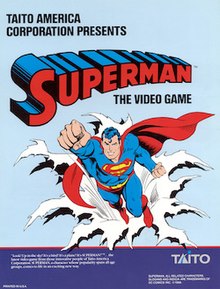
Bubble Bobble is a 1986 platform arcade game developed and published by Taito. It was distributed in the United States by Romstar, and in Europe by Electrocoin. Players control Bub and Bob, two dragons that set out to save their girlfriends from a world known as the Cave of Monsters. In each level, Bub and Bob must defeat each enemy present by trapping them in bubbles and popping, who turn into bonus items when they hit the ground. There are 100 levels total, each becoming progressively more difficult.

The NewZealand Story is a platformer arcade game developed and published by Taito in 1988. The game's concept and setting were inspired by a holiday trip in New Zealand by one of the Taito programmers. The player controls Tiki (ティキ), a kiwi who must save his girlfriend Phee Phee (ピューピュー) and several of his other kiwi chick friends who have been kidnapped by a large blue leopard seal. While avoiding enemies, the player has to navigate a scrolling maze-like level, at the end of which they release one of Tiki's kiwi chick friends trapped in a cage. In 2007, the arcade game received a remake for the Nintendo DS under the title, New Zealand Story Revolution.

Rainbow Islands: The Story of Bubble Bobble 2 (レインボーアイランド) is a 1987 arcade game developed and published by Taito. The arcade version was licensed to Romstar for North American manufacturing and distribution. The game is subtitled "The Story of Bubble Bobble 2" and is the sequel to Taito's hit game Bubble Bobble from the previous year. It is the second of four arcade games in the Bubble Bobble series. The game was ported for numerous home computers and game consoles.
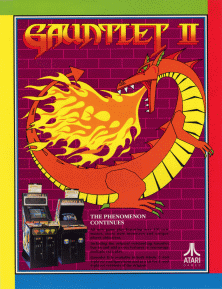
Gauntlet II is a 1986 arcade game produced by Atari Games that serves as the immediate sequel to the original Gauntlet, which was released the previous year. Like its predecessor, Gauntlet II is a fantasy-themed top down dungeon crawler game and was released as a dedicated cabinet, as well as a conversion kit, both available in 2-player and 4-player versions.

Flying Shark, known as Sky Shark in North America, is a 1987 vertically scrolling shooter arcade video game originally developed by Toaplan and published by Taito in Japan, Romstar in North America and Electrocoin in Europe. Controlling the titular biplane, the players must fight endless waves of military vehicles while avoiding collision with their projectiles and other obstacles. The plane has a powerful bomb at its disposal that can clear the screen of enemies when fired. It was the third shoot 'em up game from Toaplan, and their eighth video game overall.

Truxton is a 1988 vertically scrolling shooter arcade video game originally developed by Toaplan and published in Japan and Europe by Taito, as well in North America by Midway. Set in a future where the Gidans alien race led by Dogurava invaded the fictional planet Borogo, players assume the role of fighter pilot Tatsuo taking control of the Super Fighter ship on a last-ditch effort to overthrow the alien invaders.

Don Doko Don is a platform arcade game developed and released by Taito in 1989. In the game, the player(s) control two lumberjacks, Bob and Jim, with the objective being to clear the screen of all the enemies. Bob and Jim use their mallets to stun the enemies, pick up the enemies, then throw them at a wall, or other enemies to kill them off, resulting in bonus points. Bonus items also appear during stages that will have varying effects on the players.

The Legend of Kage is a side-scrolling hack-and-slash action game developed and released by Taito for arcades in 1985. It was ported for several contemporary video game home systems in the following years.
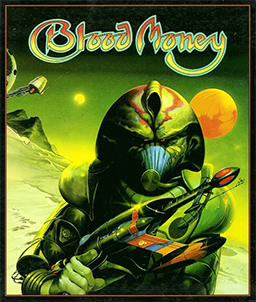
Blood Money is a side-scrolling shooter video game developed by DMA Design and published by Psygnosis in 1989 for the Amiga, Atari ST, and MS-DOS. A Commodore 64 version followed in 1990. The game is set in four different locations on a planet, where the player must fight off enemies and bosses.

Xain'd Sleena (ザインドスリーナ) is a two genre Platformer and side-scrolling arcade video game produced by Technos in 1986. It was licensed for release outside of Japan by Taito. In the USA, the game was published by Memetron, and the game was renamed to Solar Warrior. The European home computer ports renamed the game to Soldier of Light.

Rastan Saga II, known in Europe as Nastar and in North America as Nastar Warrior, is a hack and slash platform arcade game developed and released by Taito in 1988. It is the sequel to Rastan.

Arbalester is a scrolling shoot 'em up arcade game released by SETA in 1989, licensed to Taito and Romstar. The player controls a fighter jet and shoots enemies in the air and on the ground, collects power-ups, and defeats bosses to advance levels.

Rally Bike is a racing arcade video game originally developed by Toaplan and published by Taito in May 1988.

Mr. Heli, fully titled in Japan as Mr. HELI no Daibōken and known in North America as Battle Chopper, is a 1987 multidirectional scrolling shoot 'em up arcade game developed and published by Irem. The game was released in Europe as Mr. Heli.
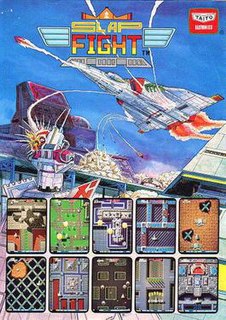
Slap Fight is a 1986 vertically scrolling shooter arcade video game originally developed by Toaplan and published by Taito. Set on the colonized fictional planet of Theron in the future, where an alien race led by Gaudy have invaded the human-controlled location, players assume the role of an Allied League of Cosmic Nations (ALCON) fighter pilot taking control of the SW475 space fighter craft in a effort to counterattack the invaders. Initially launched for the arcades, the game was later ported to other microcomputer and console platforms by various third-party developers, with each one featuring several changes or additions compared to the original release.

Aliens is a 1990 run-and-gun shooter video game developed and published for arcades by Konami. It is based on the 1986 film of the same title.
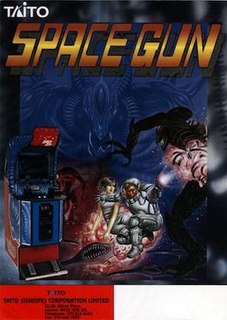
Space Gun is a 1990 first-person shooter arcade game released by Taito. The game is set aboard a crippled space station that has been overrun by hostile alien creatures. The objective is to rescue human crew members while destroying the alien creatures. The game lets the player shoot limbs off the creatures, resulting in blood splatters.
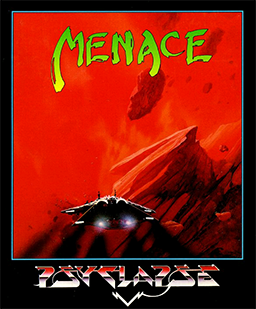
Menace is a horizontally scrolling shooter developed by DMA Design and published by Psygnosis. It was originally released for the Amiga in 1988, and was ported for the Atari ST, Commodore 64, and MS-DOS in 1989. The game is set on the planet of Draconia, where players are tasked with destroying the planet's defence mechanisms in order to kill the harmful creatures.

Kuri Kinton (功里金団) is a side-scrolling beat 'em up arcade game published by Taito. Players control a Chinese policeman who must dispatch numerous enemies while progressing through the game's levels. The object of the game is to rescue a senior policeman and his daughter, both of whom have been kidnapped by a gang and spirited away to an underground hideout.
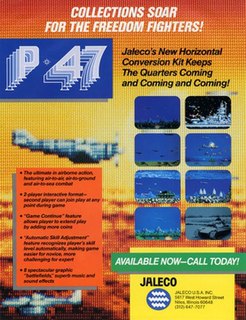
P-47: The Phantom Fighter is a 1988 horizontally scrolling shooter arcade video game originally developed by NMK and published by Jaleco. Set during World War II, players control a Republic P-47 Thunderbolt fighter aircraft to face against the Nazis, who are occupying multiple countries around the world. Its gameplay involves destroying waves of enemies, picking up power-ups and new weapons, and destroying bosses. It ran on the Mega System 1 hardware.
